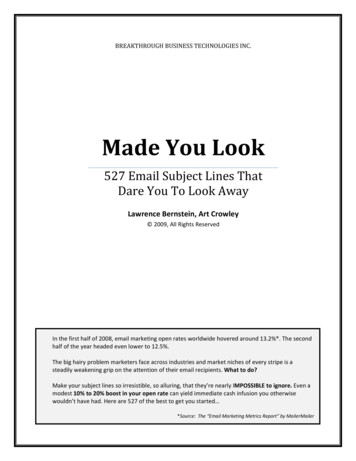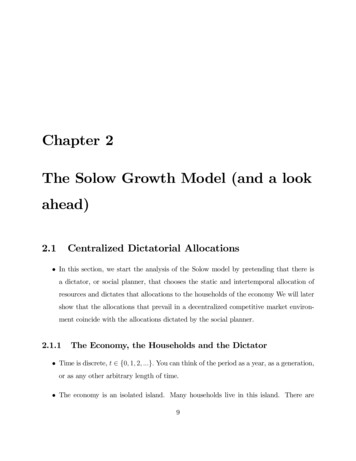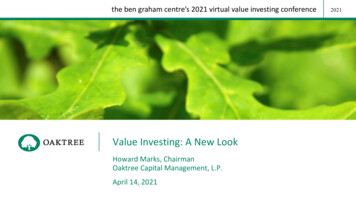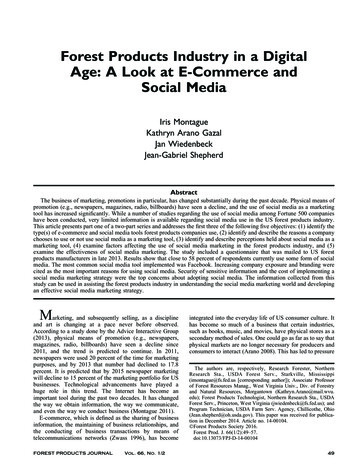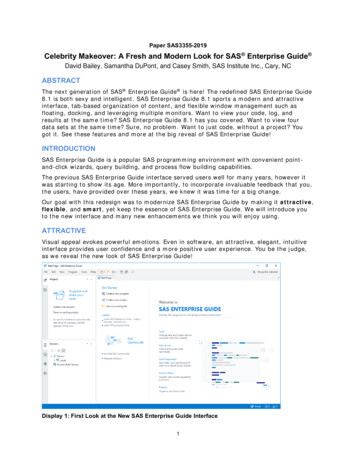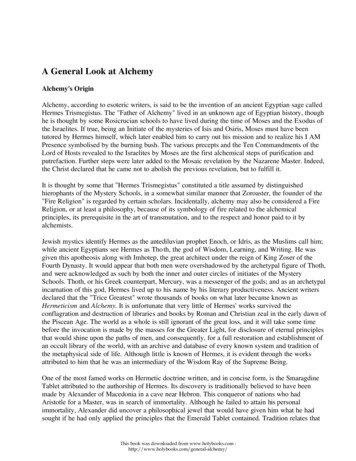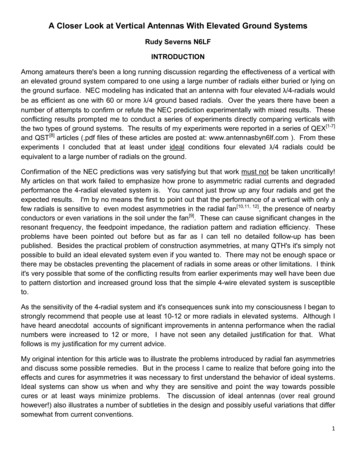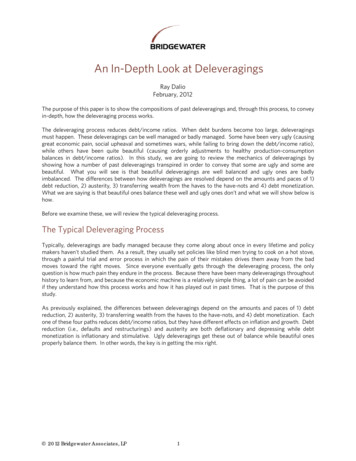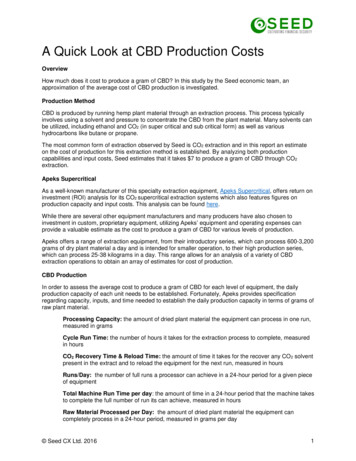
Transcription
A Quick Look at CBD Production CostsOverviewHow much does it cost to produce a gram of CBD? In this study by the Seed economic team, anapproximation of the average cost of CBD production is investigated.Production MethodCBD is produced by running hemp plant material through an extraction process. This process typicallyinvolves using a solvent and pressure to concentrate the CBD from the plant material. Many solvents canbe utilized, including ethanol and CO2 (in super critical and sub critical form) as well as varioushydrocarbons like butane or propane.The most common form of extraction observed by Seed is CO2 extraction and in this report an estimateon the cost of production for this extraction method is established. By analyzing both productioncapabilities and input costs, Seed estimates that it takes 7 to produce a gram of CBD through CO2extraction.Apeks SupercriticalAs a well-known manufacturer of this specialty extraction equipment, Apeks Supercritical, offers return oninvestment (ROI) analysis for its CO2 supercritical extraction systems which also features figures onproduction capacity and input costs. This analysis can be found here.While there are several other equipment manufacturers and many producers have also chosen toinvestment in custom, proprietary equipment, utilizing Apeks’ equipment and operating expenses canprovide a valuable estimate as the cost to produce a gram of CBD for various levels of production.Apeks offers a range of extraction equipment, from their introductory series, which can process 600-3,200grams of dry plant material a day and is intended for smaller operation, to their high production series,which can process 25-38 kilograms in a day. This range allows for an analysis of a variety of CBDextraction operations to obtain an array of estimates for cost of production.CBD ProductionIn order to assess the average cost to produce a gram of CBD for each level of equipment, the dailyproduction capacity of each unit needs to be established. Fortunately, Apeks provides specificationregarding capacity, inputs, and time needed to establish the daily production capacity in terms of grams ofraw plant material.Processing Capacity: the amount of dried plant material the equipment can process in one run,measured in gramsCycle Run Time: the number of hours it takes for the extraction process to complete, measuredin hoursCO2 Recovery Time & Reload Time: the amount of time it takes for the recover any CO2 solventpresent in the extract and to reload the equipment for the next run, measured in hoursRuns/Day: the number of full runs a processor can achieve in a 24-hour period for a given pieceof equipmentTotal Machine Run Time per day: the amount of time in a 24-hour period that the machine takesto complete the full number of run its can achieve, measured in hoursRaw Material Processed per Day: the amount of dried plant material the equipment cancompletely process in a 24-hour period, measured in grams per day Seed CX Ltd. 20161
While Apeks provides specifications on the amount of raw plant material that can be processed in a day,an assumption about the CBD content of this material needs to be made to establish estimates on thepotential daily production of pure CBD from each piece of equipment. For this study, a CBD concentrationof 10%, based on a dry weight basis, is assumed for the raw plant material. This assumption will berelaxed later through the use of a sensitivity analysis.CBD Concentration: the percentage of the plant material that is CBD on a dry weight basis,assumed to be 10% in this studyCBD Content: the amount of CBD present in the plant material that can be processed in one run,measured in grams. For this analysis, it is assumed that 100% of the CBD present in the plantmaterial is extracted.CBD Processed per Day: the amount of CBD the can be fully extracted in a 24-hour period,measured in grams per dayAdditional assumptions are put in place to arrive at a final daily CBD production capacity for each piece ofequipment. These include full technical efficiency, in that all CBD content will be removed from the plantmaterial in the extraction process, as well as a 24-hour work period.Figure 1 provides a breakdown of each of these points for the ten different pieces of equipment offered byApeks. As the processing capacity increases, the daily CBD production potential also increases, toppingout at 3.8 kilograms per day for the largest piece in their high production series.Figure 1: Daily Production CapacityHigh Production SeriesMid range Runs/DayProcessingCBDCycle Run Recovery &Concentration(24 hourCapacity (g)Content (g) Time (h)Reload(%)period)Time (h)RawTotalMaterialMachineProcessedRun Timeper dayper day (h)(g/day)CBDProcessedper ,800AssumptionsCBD ConcentrationFull CBD Extraction Seed CX Ltd. 201610%2
Costs of ProductionAfter establishing daily CBD production, daily costs need to be estimated and once again Apeks offerssome insight into input costs for its extraction equipment.Maintenance Cost per Day: each piece of extraction equipment requires the replacement ofseals, diaphragms, or general pump maintenance after a certain number of runs. The averagecost of these repairs is divided by the days until the repairs are needed to obtain a figure of dailymaintenance cost, measured in dollars.Electrical Use per Hour: the amount of electricity used by the piece of extraction equipment inan hour, measured in kW per hour.Electrical Cost per Day: the cost of running the piece of equipment for the number of full runs itcan achieve in a 24-hour period, measured in dollars.CO2 Cost per Day: the cost of CO2 solvent required to achieve the number of full runs in a 24hour period, measured in dollars.In its specification, Apeks provide estimates on the cost of labor; however, these assume that labor onlyneeds to be present during the reloading process. This assumption may be unreasonable as theseworkers will likely still need to be present during the entire process. As a result, new estimates on dailylabor costs need to be created.Labor Hours: the number of hours that a worker needs to be present to achieve the number offull runs in a 24-hour period. It is assumed that a worker needs to be fully present during allstages of the extraction process.Labor Cost: the cost of labor in to achieve the full number of runs in a 24-hour period, measuredin dollars.The daily cost of another major input, the raw plant material, also needs to be estimated as well. In thisstudy it is assumed that the average cost of dry plant material is 300 per pound or 0.66 per gram.Using this assumption, along with the daily processing capacity, a figure on daily cost of plant materialcan be achieved.Daily Cost of Dry Plant Material: the cost of the total amount of dry plant material that can beprocessed in a 24-hour period, measured in dollars.Figure 2 provides a breakdown of each of these points for the ten different pieces of equipment offered byApeks, with daily costs running from as low as 800 per day for its smallest extraction equipment to over 25,000 per day for its largest piece of equipment in its high production series. Seed CX Ltd. 20163
Figure 2: Daily CostsVariable CostsFixed CostHigh Production SeriesMid range ProdcuctionSeriesIntroductorySeriesEquipmentTotal DailyLabor CostOperational( )Cost ( )Equipment CostDaily Cost of DryPlant Material ( )Maintenance Costper day ( )Electrical Use perHour (kW/h)Electrical Cost perday ( )CO2 Cost per day( )LaborHours (h) 39,000 446 188.9 34 1121.0 336 8441500-1L2000-5LD 79,000 2,112 88.9 31 1219.5 312 2,4752000-20LD 135,000 7,128 713.5 49 820.0 320 7,5122000-5Lx5LD 121,000 8,448 68.5 37 1124.0 384 8,8862000-5Lx20LD 149,000 9,240 813.5 58 824.0 384 9,6982000-20Lx20LD 168,000 7,128 713.5 47 419.5 312 7,4985000-5LDP 194,000 16,896 1513.5 58 6024.0 384 17,4135000-5Lx5LDP 279,000 19,008 1413.5 55 3422.5 360 19,4715000-20Lx20LDP 359,000 21,384 1413.5 55 1122.5 360 21,8245000-40Lx40LDP 475,000 25,080 1513.5 58 824.0 384 25,545AssumptionsCost of CO2 ( /lb)Cost of Electricity ( /kW)Cost of Labor ( /h)Cost of Inputs ( /lb)Cost of Inputs ( /g)1.250.18163000.66Average Variable CostAfter determining the daily cost and production capacities for each piece of equipment, a figure onaverage variable cost can be established for each unit. Figure 3 provides a breakdown of this for eachpiece of equipment with the average variable cost stabilizing at around 7 per gram of CBD as productioncapacity increases.High Production SeriesMid range ProdcuctionSeriesIntroductorySeriesFigure 3: Average Variable Cost Seed CX Ltd. 2016ProductionCapacity (g/day)Total DailyOperational Cost( )Average CBDProduction Cost( /g)1500-1L68 844.14 12.512000-5LD320 2,475.24 7.742000-20LD1,080 7,511.60 6.962000-5Lx5LD1,280 8,885.72 6.942000-5Lx20LD1,400 9,698.32 6.932000-20Lx20LD1,080 7,498.39 6.945000-5LDP2,560 17,413.32 6.805000-5Lx5LDP2,880 19,470.68 6.765000-20Lx20LDP3,240 21,823.68 6.745000-40Lx40LDP3,800 25,545.32 6.724
Sensitivity AnalysisSeveral assumptions were made regard the CBD concentration of the raw plant material and the cost ofthis raw plant material. Figure 4 provides a sensitivity analysis that relaxes these two assumption toobtain an array of average cost estimates for Apeks’ largest extraction unit in its high production series,the 5000 -40Lx40LDP.Figure 4: Sensitivity Analysis for 5000-40Lx40LDP - CBD Concentration and Cost of FlowerFlower Cost:Dollars perpoundCBD Concentration 10 20 50 100 200 300 400 500 6001%3%5%7%10%12%14%16%18%20% 3.45 5.67 12.34 23.45 45.67 67.89 90.11 112.34 134.56 1.15 1.89 4.11 7.82 15.22 22.63 30.04 37.45 44.85 0.69 1.13 2.47 4.69 9.13 13.58 18.02 22.47 26.91 0.49 0.81 1.76 3.35 6.52 9.70 12.87 16.05 19.22 0.34 0.57 1.23 2.34 4.57 6.79 9.01 11.23 13.46 0.29 0.47 1.03 1.95 3.81 5.66 7.51 9.36 11.21 0.25 0.40 0.88 1.67 3.26 4.85 6.44 8.02 9.61 0.22 0.35 0.77 1.47 2.85 4.24 5.63 7.02 8.41 0.19 0.31 0.69 1.30 2.54 3.77 5.01 6.24 7.48 0.17 0.28 0.62 1.17 2.28 3.39 4.51 5.62 6.73LimitationsThis method of estimating CBD production costs has several limitations. First and foremost, theseaverage costs only apply to production processes using Apeks’ extraction equipment. While thisequipment manufacturer is well known and widely used by many within the CBD processing industry, alarge majority of firms devoted to large scale CBD processing own custom and proprietary extractionequipment which may differ significantly in their output potential and input cost. As a result, averageproduction cost for these large-scale processors may be different from those presented here. Second,while utilizing different sizes of processing equipment can give an idea to how average cost changes asproduction is scaled up, it is not perfect as each piece of equipment behaves differently and producesdifferent results. Finally, while this figure represents the average cost to produce a gram of CBD from dryplant material to extract, many processors chose to apply additional stages of processing and refiningafter the first run which can also significantly alter the average cost.While this represents an estimate on costs for CO2 extraction, many producers may choose to use othersolvents in their production process which may also significantly alter costs of production.ConclusionThis study attempts to take a quick look at how much it costs to produce a gram of CBD in extract form.While several assumptions had to be made and limitations put in place, an ultimate figure of 7 per gramof CBD was reached. Seed CX Ltd. 20165
Apeks, with daily costs running from as low as 800 per day for its smallest extraction equipment to over 25,000 per day for its largest piece of equipment in its high production series.

